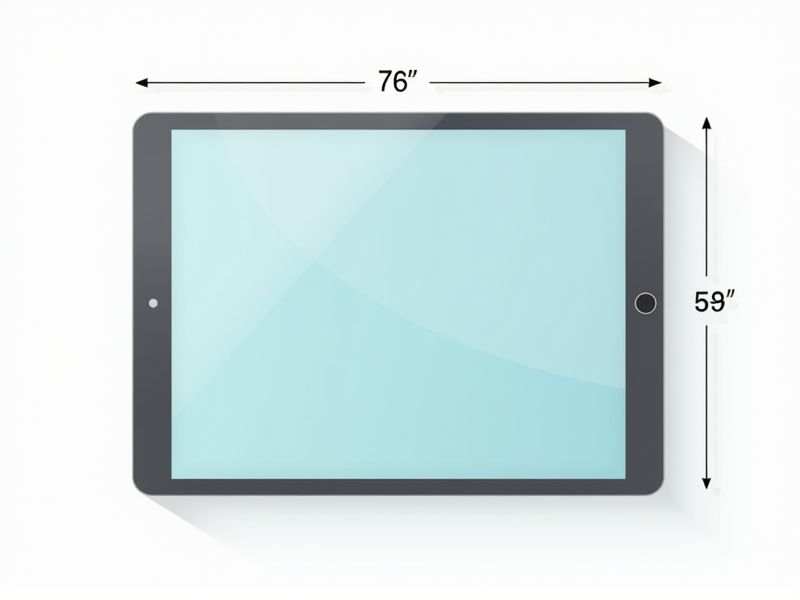
Tablet screens come in a range of standard sizes, typically measured diagonally in inches. The most common dimensions include 7-inch, 8-inch, and 10-inch screens, which correspond to portable, mid-size, and full-size tablet categories. For example, a 10-inch tablet often has a screen resolution of 1920x1200 pixels and a physical screen area around 8.5 x 5.3 inches. Knowing these standard dimensions can help you choose the right tablet for reading, streaming, or productivity based on your needs.
Aspect Ratio
The aspect ratio of a tablet screen significantly influences your viewing experience, with common ratios such as 16:10 and 4:3 dominating the market. A 16:10 aspect ratio provides an ideal balance for watching videos and gaming, offering a wide field of vision with minimal visual obstructions. In contrast, a 4:3 ratio is often preferred for reading and productivity, as it offers more vertical space for documents and web pages. Understanding these ratios can help you choose a device that best suits your entertainment or work needs.
Pixel Density
Pixel density, measured in pixels per inch (PPI), is crucial for determining the clarity and sharpness of a tablet's display. A higher pixel density, such as 300 PPI or more, typically results in more vivid images and smoother text, enhancing your viewing experience. Most modern tablets feature pixel densities ranging from 200 PPI to 500 PPI, with options like Apple's Retina displays pushing boundaries beyond this. Choosing a device with a higher pixel density can significantly improve your enjoyment of multimedia content, gaming, and reading.
Resolution
The standard resolution for high-quality tablet screens typically ranges from 1920 x 1200 pixels to 2560 x 1600 pixels, offering sharp images and vibrant colors. Tablets with a resolution of 2048 x 1536 pixels, such as the iPad, deliver stunning detail that enhances reading and multimedia experiences. For an immersive viewing experience, consider options with higher pixel densities, exceeding 300 pixels per inch (PPI), which result in clearer text and smoother graphics. Your choice should focus on resolutions that not only meet your visual needs but also provide an optimal balance between performance and battery life.
Screen Size
Tablet screen sizes typically range from 7 to 12.9 inches diagonally, catering to various user needs and preferences. For instance, 10-inch tablets offer a balanced blend of portability and usability, making them ideal for reading or watching videos. Larger screens, such as those around 12.9 inches, provide enhanced productivity, suitable for tasks like graphic design or multitasking with split views. When choosing a tablet, consider how screen size affects your overall experience, including comfort, readability, and application usage.
Bezel Thickness
Bezel thickness plays a crucial role in defining the overall aesthetics and usability of tablet screens. Modern tablets typically feature bezels ranging from 2 mm to 10 mm, with thinner bezels providing a more immersive viewing experience and a larger active screen area. A minimal bezel of around 2 mm can enhance your engagement, especially during multimedia consumption and gaming. The ideal bezel thickness varies depending on personal preference, but a balance between aesthetics and functionality is vital for optimal screen interaction.
Color Accuracy
Color accuracy on tablet screens is quantified using metrics such as Delta E, with values below 2 indicating excellent color fidelity. High-end tablets often feature wide color gamuts, such as DCI-P3 or Adobe RGB, which enhance the vibrancy and realism of displayed images, achieving up to 99% coverage in some models. Calibration tools are essential for professional use, allowing users to fine-tune settings for optimal performance. When selecting a tablet, consider both the display technology--like OLED or LCD--and the manufacturer's promises regarding color reproduction standards to ensure the best possible visual experience.
Refresh Rate
The refresh rate of tablet screens, typically measured in hertz (Hz), significantly impacts your viewing experience, with common rates being 60Hz, 90Hz, or even 120Hz in premium models. A higher refresh rate provides smoother motion and reduces blur during fast-paced activities, such as gaming or video playback. For instance, a 120Hz refresh rate can make scrolling through documents or web pages appear more fluid and responsive. When choosing a tablet, consider how the refresh rate aligns with your primary usage, as it can greatly enhance your enjoyment and productivity.
Brightness Levels
Tablet screen brightness levels typically range from 200 to 600 nits, catering to various environments and user preferences. A higher brightness level enhances visibility in bright outdoor settings, while lower settings can reduce eye strain in dimly lit areas. Many tablets now include adaptive brightness technology, automatically adjusting based on ambient light conditions to optimize user experience. When choosing a tablet, consider your usage habits; if you frequently use it outdoors, opt for models with higher brightness capabilities for better clarity and comfort.
Touch Sensitivity
Tablet screen touch sensitivity is typically measured in terms of response time and pressure levels, with many modern devices offering at least 10 to 15 milliseconds response time. High-end tablets often feature between 2048 to 8192 pressure sensitivity levels, allowing for a more nuanced touch experience, perfect for drawing or detailed tasks. Manufacturers like Apple and Samsung utilize advanced technologies such as capacitive touch and palm rejection to enhance user interaction. Ensuring optimal touch sensitivity can significantly improve your overall experience, especially in creative and productivity applications.
Display Technology
Tablet screen display technology has evolved significantly, with today's devices often featuring impressive resolutions such as 2560 x 1600 pixels or higher. Most modern tablets utilize IPS (In-Plane Switching) technology, which offers wider viewing angles and better color reproduction, crucial for media consumption and graphic design. The introduction of AMOLED displays has enhanced contrast ratios, providing deeper blacks and vibrant colors, revolutionizing your visual experience. With brightness levels exceeding 500 nits in many models, viewing clarity under bright sunlight has been optimized for outdoor usage.
